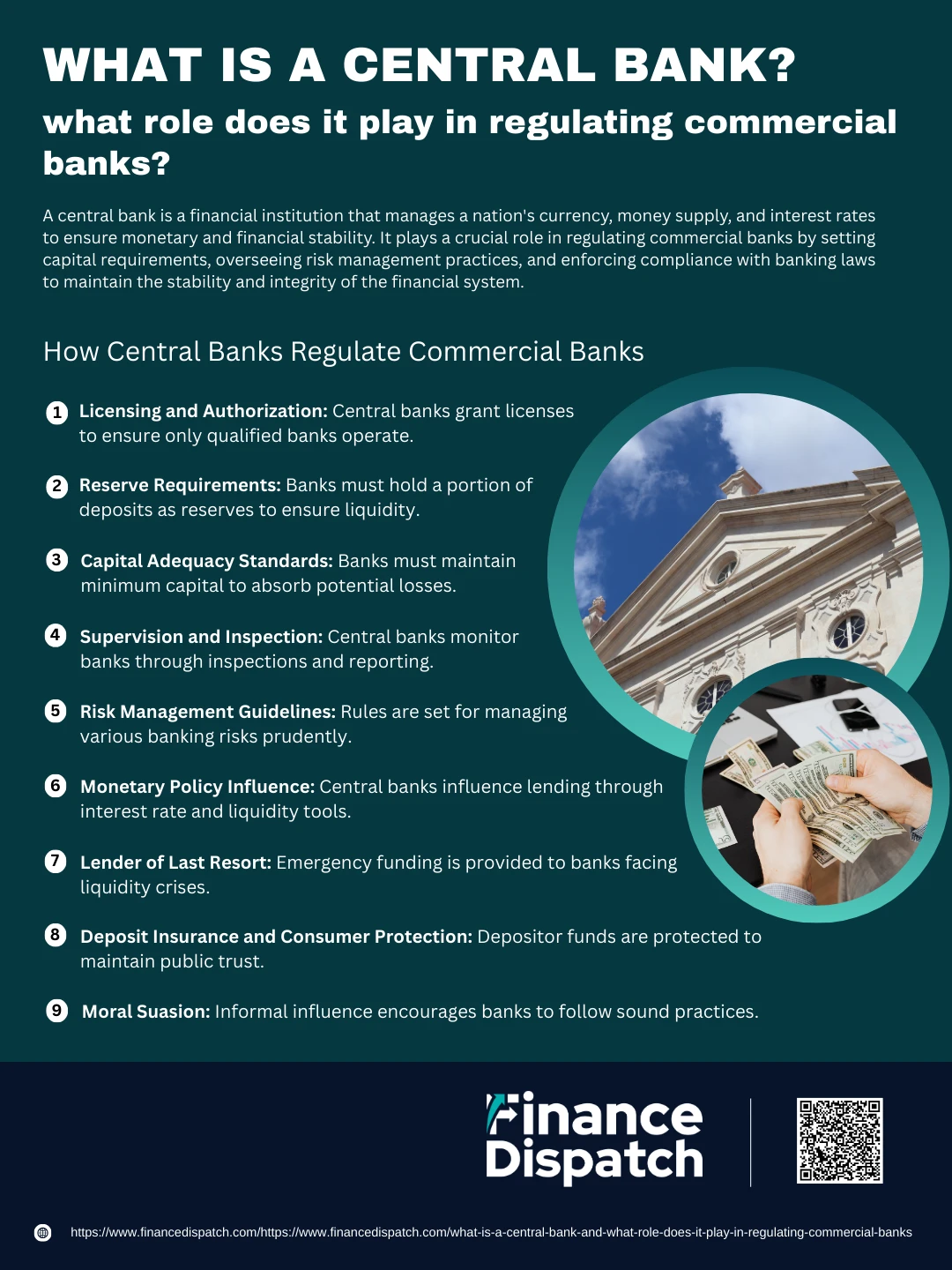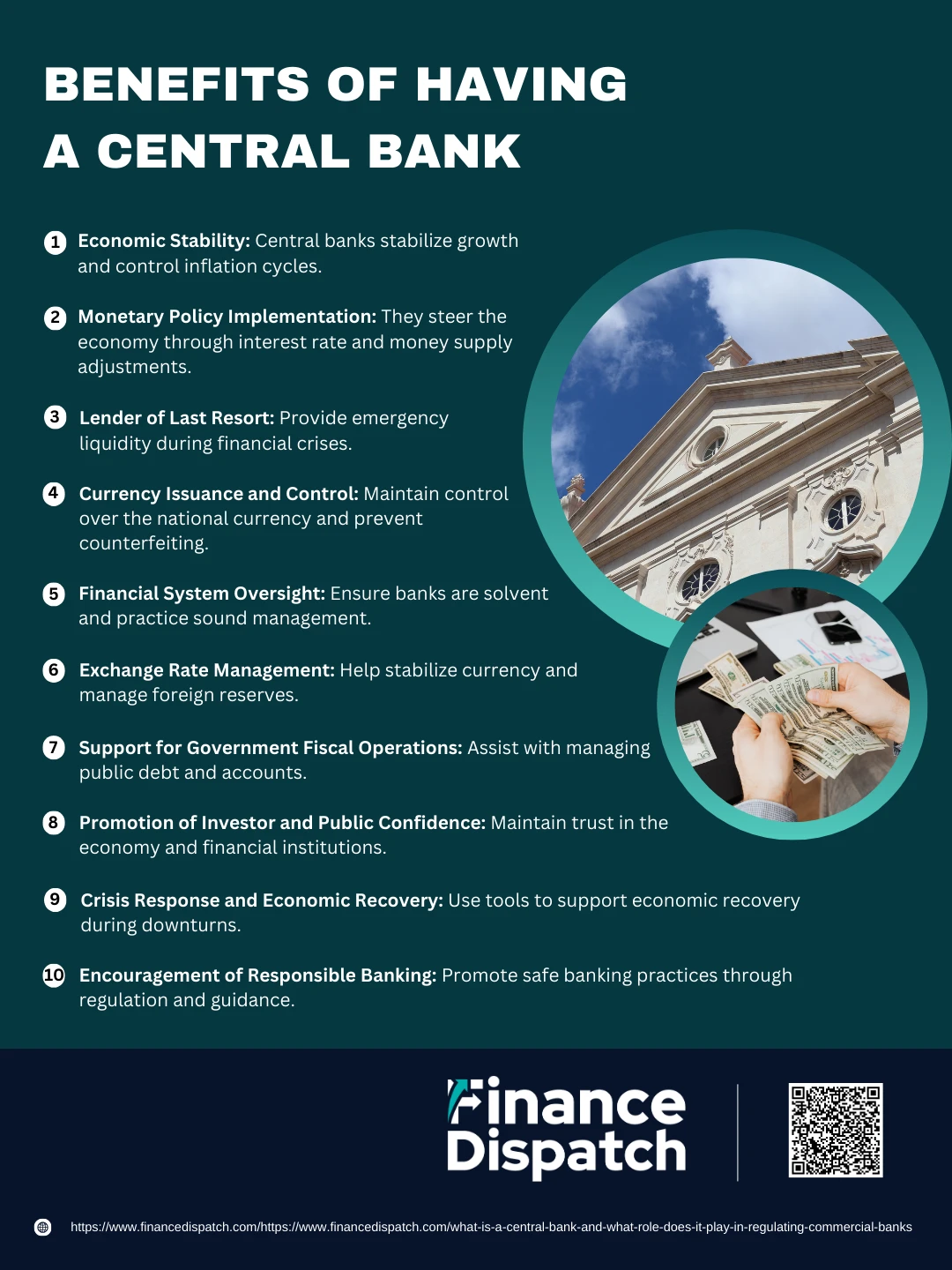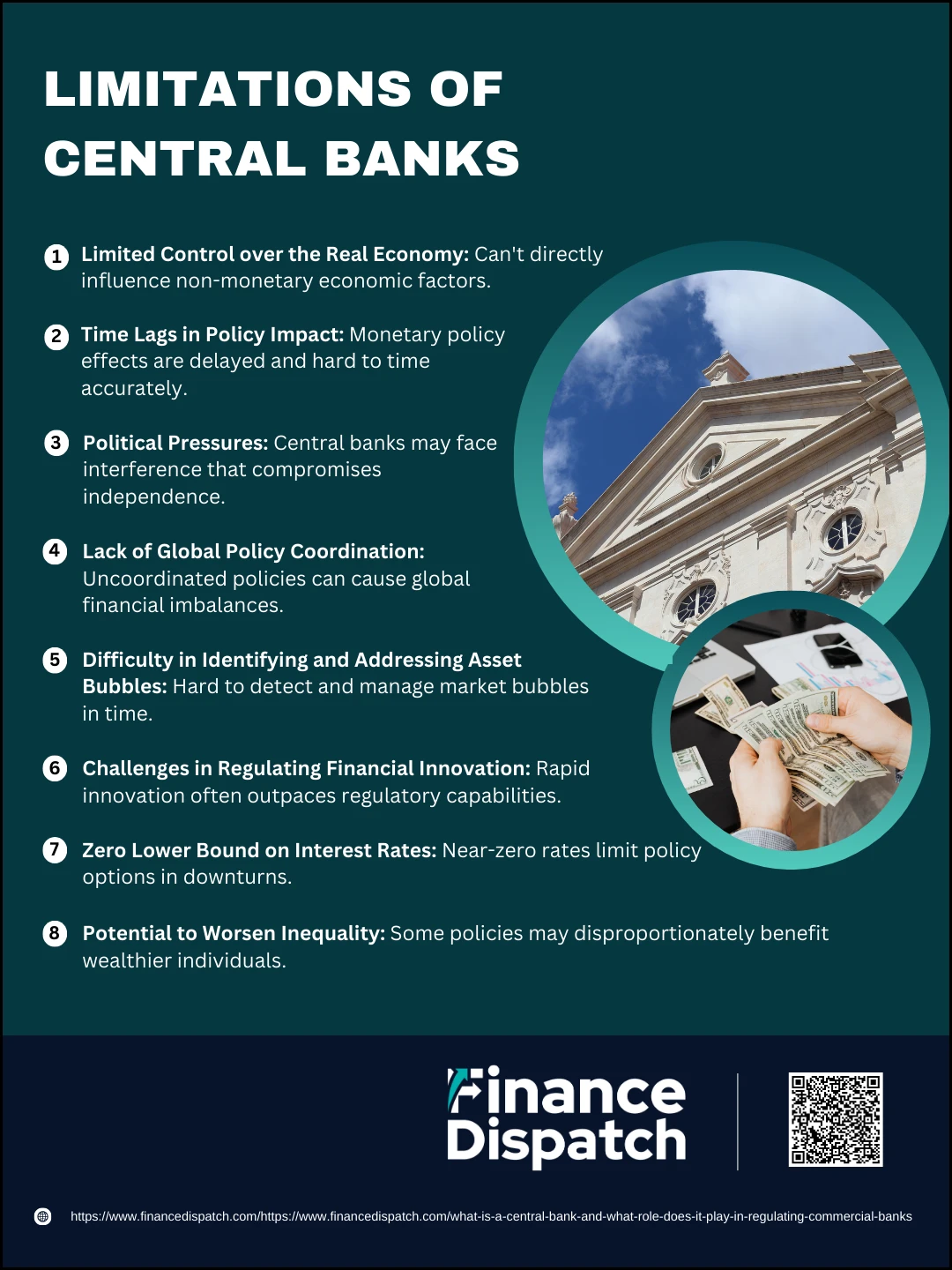A central bank is the cornerstone of a nation’s financial system, tasked with managing the supply of money, setting interest rates, and ensuring overall economic stability. Unlike commercial banks that deal directly with the public, central banks operate at the macroeconomic level, influencing the broader financial landscape through monetary policy and regulation. One of their most crucial responsibilities is overseeing and regulating commercial banks to ensure the soundness of the banking sector, protect depositors, and prevent financial crises. Understanding what a central bank is—and how it governs commercial banks—sheds light on the mechanisms that safeguard modern economies and maintain public confidence in the financial system.
What is a Central Bank?
A central bank is a national financial institution that serves as the authority in charge of a country’s monetary system. It is responsible for managing the money supply, setting benchmark interest rates, issuing currency, and maintaining financial stability. Unlike commercial banks, which serve individuals and businesses, a central bank operates independently of market competition and does not offer services to the general public. Instead, it provides banking services to the government and commercial banks, acting as a banker’s bank. Its primary goal is to foster economic stability by controlling inflation, supporting employment, and ensuring a secure and efficient payment system. Through its various functions, the central bank plays a pivotal role in shaping the economic health and policy direction of a nation.
 How Central Banks Regulate Commercial Banks
How Central Banks Regulate Commercial Banks
Central banks are the backbone of a nation’s financial stability, and one of their most important roles is regulating commercial banks. These regulations are designed to ensure that banks operate safely, manage risks prudently, and contribute to the stability of the overall financial system. Without proper oversight, commercial banks might take excessive risks that could lead to bank failures, loss of public trust, or even economic crises. Central banks use a combination of legal authority, policy tools, and ongoing supervision to guide the behavior of commercial banks and protect the economy.
Key Ways Central Banks Regulate Commercial Banks:
1. Licensing and Authorization
Before a commercial bank can operate; it must be licensed by the central bank. This process involves a thorough assessment of the bank’s capital base, management team, operational plans, and compliance with legal requirements. Licensing ensures that only qualified and trustworthy institutions are allowed to handle public deposits.
2. Reserve Requirements
Central banks require commercial banks to hold a certain percentage of their deposits as reserves, either in their own vaults or with the central bank. These reserves ensure that banks can meet withdrawal demands and help the central bank control the amount of money circulating in the economy.
3. Capital Adequacy Standards
To protect against losses, commercial banks must maintain a minimum level of capital relative to their assets. Central banks enforce these standards to ensure banks can withstand financial shocks without collapsing, thus safeguarding the broader economy.
4. Supervision and Inspection
Central banks regularly monitor and inspect commercial banks through on-site visits and off-site reporting. They examine a bank’s financial health, asset quality, lending practices, and risk management systems. If issues are found, the central bank may require corrective action or impose penalties.
5. Risk Management Guidelines
Central banks establish rules for how commercial banks should manage risks, including credit risk (loan defaults), market risk (investment losses), and operational risk (internal failures). These guidelines help ensure banks operate responsibly and avoid dangerous practices.
6. Monetary Policy Influence
By setting policy interest rates and using tools like open market operations, central banks influence the cost of borrowing. This indirectly affects how much commercial banks lend, thereby guiding credit growth and controlling inflation or economic overheating.
7. Lender of Last Resort
During times of crisis, when a commercial bank faces liquidity shortages, the central bank can provide emergency loans. This function prevents panic and ensures the banking system continues to function even under stress.
8. Deposit Insurance and Consumer Protection
Many central banks oversee or coordinate with deposit insurance schemes, which guarantee depositors’ money up to a certain limit if a bank fails. This protects savers and maintains confidence in the banking system.
9. Moral Suasion
In addition to formal regulations, central banks may use moral suasion—informal persuasion or advice—to encourage commercial banks to adopt prudent policies, comply with regulatory expectations, and act in the public interest without the need for strict enforcement.
Primary Functions of a Central Bank
A central bank plays a vital role in managing a country’s financial and economic stability. Unlike commercial banks that serve individuals and businesses, a central bank operates at the national level, overseeing monetary policy, regulating financial institutions, and ensuring the smooth functioning of the financial system. Its functions are critical to maintaining confidence in a country’s currency and the overall health of the economy.
Key Functions of a Central Bank
1. Issuance of Currency: The central bank has the exclusive authority to issue the national currency, ensuring its authenticity, availability, and security.
2. Monetary Policy Implementation: It manages interest rates and the money supply to control inflation, stabilize prices, and support economic growth.
3. Lender of Last Resort: In times of financial distress, the central bank provides emergency funding to commercial banks to prevent collapses and maintain system stability.
4. Regulation and Supervision of Banks: It oversees commercial banks to ensure they follow rules, manage risks properly, and remain financially sound.
5. Foreign Exchange Management: The central bank maintains and manages the country’s foreign exchange reserves and may intervene in currency markets to stabilize exchange rates.
6. Maintaining Financial Stability: Through proactive monitoring and policy tools, the central bank works to prevent systemic risks and financial crises.
7. Custodian of Government Accounts: It acts as a banker to the government, managing its accounts, issuing public debt, and helping finance fiscal operations.
8. Payment System Oversight: The central bank ensures the safety and efficiency of the national payment and settlement systems used for transactions between banks and financial institutions.
Overview of Commercial Banks
Commercial banks are financial institutions that primarily provide services to the general public, businesses, and industries. Their main functions include accepting deposits, offering loans, and facilitating financial transactions such as fund transfers and bill payments. Unlike central banks, commercial banks operate for profit and compete in the financial marketplace. They play a crucial role in economic development by channeling savings into productive investments and offering credit facilities to individuals and organizations.
Comparison Table: Key Features of Commercial Banks
| Feature | Description |
| Primary Clients | General public, businesses, and small industries |
| Main Functions | Accepting deposits, providing loans, and facilitating financial transactions |
| Profit Orientation | Operate for profit through interest margins and service charges |
| Regulatory Authority | Regulated and supervised by the central bank |
| Deposit Services | Offer savings accounts, checking accounts, and fixed deposits |
| Loan Services | Provide personal loans, business loans, mortgages, and credit facilities |
| Revenue Source | Interest on loans, fees, and commissions |
| Public Accessibility | Open to individuals and businesses for day-to-day banking needs |
| Number in a Country | Many commercial banks operate in each country |
| Role in Economy | Promote financial inclusion and economic growth by supporting lending and investment |
Tools Used by Central Banks for Regulation
Central banks use a range of powerful tools to regulate the banking system and maintain economic stability. These tools are essential for controlling inflation, managing the money supply, stabilizing interest rates, and ensuring that commercial banks operate within a safe and sound framework. By applying these instruments effectively, central banks can influence credit availability, guide economic growth, and protect the financial system from crises.
Key Regulatory Tools Used by Central Banks
1. Open Market Operations (OMO): Buying or selling government securities in the open market to control liquidity and influence short-term interest rates.
2. Reserve Requirements: Setting the minimum percentage of customer deposits that commercial banks must hold as reserves, limiting their ability to lend.
3. Policy Interest Rates: Adjusting benchmark interest rates (like the repo or federal funds rate) to influence borrowing costs and overall economic activity.
4. Discount Rate (Bank Rate): The rate at which commercial banks can borrow from the central bank; changes to this rate affect the cost of borrowing across the economy.
5. Moral Suasion: Persuading banks to follow certain policies or guidelines through informal communication and public statements rather than legal enforcement.
6. Capital Adequacy Norms: Requiring commercial banks to maintain a minimum capital level to cover risks, ensuring they remain solvent during financial stress.
7. Supervisory Audits and Inspections: Conducting regular checks on the financial health and practices of commercial banks to enforce compliance and manage risks proactively.
8. Liquidity Adjustment Facility (LAF): Managing short-term liquidity needs of banks by allowing them to borrow or deposit funds with the central bank.
 Benefits of Having a Central Bank
Benefits of Having a Central Bank
A central bank plays a foundational role in shaping a country’s economic direction and maintaining the stability of its financial system. Its functions go beyond managing the supply of money; it ensures confidence in the banking sector, protects the value of the national currency, and acts as a buffer during financial shocks. By operating independently from political pressures, a central bank is better positioned to make long-term, stability-focused decisions that promote sustainable growth, low inflation, and a healthy banking environment. Below are some of the most important benefits of having a central bank in place.
1. Economic Stability: Central banks help stabilize the economy by controlling inflation and minimizing the impact of business cycle fluctuations. Their policies aim to avoid extreme booms and busts, fostering consistent growth.
2. Monetary Policy Implementation: They control interest rates and money supply to influence economic activities such as investment, consumption, and employment. This allows central banks to stimulate or cool down the economy when needed.
3. Lender of Last Resort: In times of financial crisis or liquidity shortage, central banks provide emergency funds to commercial banks. This prevents bank runs and maintains confidence in the financial system.
4. Currency Issuance and Control: Central banks have the sole authority to issue national currency, ensuring uniformity, preventing counterfeiting, and maintaining control over money in circulation.
5. Financial System Oversight: commercial banks, central banks help ensure that banks are solvent, well-capitalized, and practicing sound risk management—thereby protecting depositors and the financial system.
6. Exchange Rate Management: Central banks manage foreign currency reserves and may intervene in foreign exchange markets to stabilize their currency, supporting trade competitiveness and reducing volatility.
7. Support for Government Fiscal Operations: They manage government accounts, assist in issuing government bonds, and often help finance government deficits without undermining economic stability.
8. Promotion of Investor and Public Confidence: A stable financial environment, maintained by the central bank, encourages investor activity and builds public trust in the economy and financial institutions.
9. Crisis Response and Economic Recovery: Central banks can act swiftly in times of recession by using tools such as interest rate cuts or quantitative easing to stimulate demand and accelerate recovery.
10. Encouragement of Responsible Banking: Through regulations, audits, and advisory guidance, central banks encourage commercial banks to lend responsibly and avoid risky behavior that could threaten the wider economy.
 Limitations of Central Banks
Limitations of Central Banks
Central banks are critical to maintaining monetary and financial stability, yet their power is not absolute. Although they possess various tools to influence interest rates, control inflation, and manage the money supply, their effectiveness is bounded by structural, political, and global economic realities. The complexity of modern economies means that central banks often face trade-offs and uncertainties. Their policies may not always yield the intended outcomes, especially when dealing with unpredictable external shocks or when monetary tools reach their limits. Acknowledging these limitations helps in forming realistic expectations about what central banks can achieve.
Key Limitations of Central Banks:
1. Limited Control over the Real Economy
Central banks can influence the cost and availability of credit but cannot directly control factors like employment, productivity, technological change, or consumer confidence. These are driven by deeper market dynamics and societal trends beyond monetary policy’s reach.
2. Time Lags in Policy Impact
The effects of monetary policies are not immediate. For example, a change in interest rates may take several quarters to influence consumer spending, business investment, and inflation. This lag complicates decision-making and makes it hard to respond precisely to fast-moving economic conditions.
3. Political Pressures
Despite being designed as independent entities, central banks often face subtle or overt political influence, especially during election cycles or economic downturns. Such interference can compromise the bank’s long-term objectives, like inflation control, in favor of short-term growth or popularity.
4. Lack of Global Policy Coordination
In today’s globalized economy; the policies of one central bank (like the Federal Reserve) can impact other economies through capital flows and currency fluctuations. Without consistent international coordination, central bank policies may unintentionally trigger instability in other countries.
5. Difficulty in Identifying and Addressing Asset Bubbles
Central banks may struggle to detect financial bubbles—like in housing or stock markets—until after they burst. Acting too soon may stifle growth, while waiting too long could lead to economic crises. Moreover, monetary tools may not be well-suited to target specific sectors without unintended side effects.
6. Challenges in Regulating Financial Innovation
Rapid technological changes and complex financial products (e.g., derivatives, cryptocurrencies) often emerge faster than regulatory frameworks can adapt. This creates blind spots in oversight and exposes the financial system to new, poorly understood risks.
7. Zero Lower Bound on Interest Rates
Once interest rates are near zero, central banks have little room to cut further. This limits their ability to stimulate the economy through conventional means, forcing reliance on unconventional tools like quantitative easing, which carry their own risks and uncertainties.
8. Potential to Worsen Inequality
Some central bank actions, especially during periods of economic crisis, can unintentionally benefit wealthier individuals and large financial institutions. Asset purchases, for instance, may inflate stock prices and real estate values, widening the gap between asset-owning elites and the general population.
Importance of Regulation for Economic Stability
Regulation is essential for maintaining economic stability, as it ensures that financial institutions operate safely, transparently, and fairly within the broader economy. Without proper oversight, banks and other financial entities may engage in excessive risk-taking, fraud, or unsustainable lending practices, which can lead to crises such as bank failures, inflation spikes, or market collapses. By enforcing rules on capital adequacy, liquidity, and lending practices, regulatory bodies—particularly central banks—create a more predictable and resilient financial environment. This stability fosters investor confidence, protects consumers, and enables sustainable economic growth. In short, regulation acts as a safeguard against instability and is fundamental to the long-term health of any economy.
Case Example: Central Bank Intervention in a Crisis
Central banks often play a decisive role during financial crises by stepping in to stabilize markets, restore confidence, and prevent economic collapse. A well-known example is the intervention of the U.S. Federal Reserve during the 2008 global financial crisis. Faced with the collapse of major financial institutions and a severe credit crunch, the central bank deployed a range of emergency measures to support the banking system and revive the economy. These actions illustrate how central banks use their tools in extraordinary ways when the financial system is under stress.
Key Actions Taken by the U.S. Federal Reserve during the 2008 Crisis:
- Lowered Interest Rates to Near Zero: To reduce borrowing costs and stimulate spending and investment.
- Provided Emergency Liquidity to Banks: Through programs like the Term Auction Facility, the Fed offered short-term loans to banks facing liquidity shortages.
- Launched Quantitative Easing (QE): The Fed purchased large quantities of government bonds and mortgage-backed securities to inject liquidity into the financial system.
- Guaranteed Bank Deposits and Money Market Funds: To restore public confidence and prevent panic withdrawals.
- Bailed Out Key Financial Institutions: Supported entities like AIG and facilitated the rescue of others to avoid systemic collapse.
- Established Special Lending Facilities: Created targeted programs to support credit markets for households, small businesses, and students.
- Increased Transparency and Communication: Provided forward guidance to reassure markets about future policy directions.
Conclusion
Central banks are indispensable institutions that anchor a country’s financial and economic stability. Through their ability to implement monetary policy, regulate commercial banks, and act as a lender of last resort, they play a critical role in safeguarding the economy from inflation, recessions, and financial crises. Their regulatory functions ensure that commercial banks operate within safe boundaries, protecting both depositors and the broader financial system. While central banks are not without limitations, their presence enhances public trust, promotes sustainable growth, and provides a stabilizing force in uncertain times. As economies continue to evolve, the role of central banks in maintaining order and resilience remains more vital than ever.



